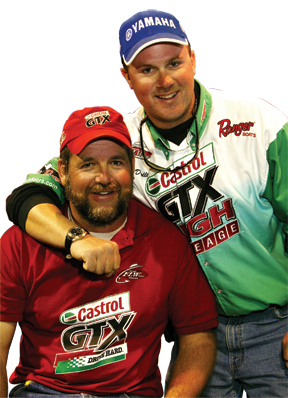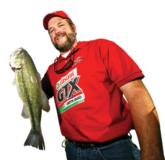Performance Profile: Darrell Stevens

Patience may be a virtue for most folks, but it is an absolute necessity for a bass-tournament co-angler.
Co-anglers have no choice but to stay calm and levelheaded as the guy in the front of the boat runs the show.
Darrell Stevens knows this well, which is why he is one of the most consistent co-anglers on the Wal-Mart FLW Tour.
“One thing about Darrell is he is probably the most patient guy I know,” said Lelia Stevens, the fisherman’s wife of 27 years.
Her husband said he does not let himself get distracted by the pro in the front of the boat.
“I just always remind myself that I’m not competing with him,” said Stevens, a 46-year-old self-employed auto mechanic from Roseland, Va. “We’re not supposed to catch as many as those guys. I’m competing against the other co-anglers.” And he is often beating them.
At press time, Stevens stood as the Wal-Mart FLW Tour’s all-time career money winner as a co-angler, with earnings totaling more than $98,000. Given his propensity to score in the top 10, however, he won’t stay under $100,000 for long. Stevens’ impressive track record includes a win at Wheeler Lake in 1998 and 11 top-10 finishes, an FLW Tour record.
One of his career highlights was the day he bested the guy in the front, boating four keepers while the pro zeroed. The unlucky front-seater was Castrol pro David Dudley, not only one of the toughest guys on the tour but also Stevens’ good friend, hunting buddy, frequent traveling companion and pretournament practice partner.
“He sits back there and concentrates on his fishing,” Dudley said. “He doesn’t watch the guy in front like a hawk.”
 Dudley, who named his Rabbit Dog spinnerbait in honor of Stevens’ brush-busting beagles, does not mind throwing unsolicited advice at his older friend.
Dudley, who named his Rabbit Dog spinnerbait in honor of Stevens’ brush-busting beagles, does not mind throwing unsolicited advice at his older friend.
“If I see him lounging, or maybe making a bad cast, I’ll let him know,” Dudley said. “He’s just a good all-around fisherman, and he’s getting better and better.”
Married just out of high school, Stevens spent his early adult life working hard to support his young family. When he hunted or fished, it was not simply for fun, but to help feed the family.
Eventually Stevens hooked up with a buddy who liked to fish for bass. In 1986, when the man got a new boat, Stevens ended up with the old one. He joined a bass club and started competing in small tournaments.
Stevens entered his first Wal-Mart FLW Tour event in 1997, fishing in three events. The next year he fished all six events and finished fourth in the final points standings, still his best season to date.
Stevens, who has been known to throw a bear roast in a Crock-Pot in a motel room before a day of tournament fishing, does not compete only as a co-angler. In recent years he has been fishing as a pro in EverStart Series events, a practice he plans to continue.
Dudley said he could see his friend achieving success as a pro.
“He can do it if he just keeps practicing,” Dudley said.
Stevens said he is content with his career’s progression and plans to let things unfold as they happen. That is probably not a bad plan. As the saying goes, good things often come to those who wait.
Walking the dog
Darrell Stevens loves hunting with dogs, whether it is following his beagles through nasty briars or following baying hounds hot on the track of a big black bear. So it should not be a surprise that “walking the dog” with a Zara Spook is one of his favorite bass-fishing techniques.
“Any time after the spawn and into the fall, a Spook can work,” Stevens said.
Spooks are traditionally good baits for early mornings, especially if bass are schooling and attacking baitfish, but Stevens is not afraid to throw one at all hours.
“A little chop will help if it’s sunny,” Stevens said. “If it’s cloudy you can catch them when it’s slick.”
Stevens usually throws either a traditional 4 1/2-inch Spook or the smaller Spook Junior, almost always tied to 14-pound-test mono.
Stevens said using the right rod helps achieve the perfect side-to-side action for which the Spook is famous.
“I throw it on a limber 7-foot cranking rod,” Stevens said. “That rod is also more forgiving when you get them close to the boat and can’t afford to have them throw the hooks.”